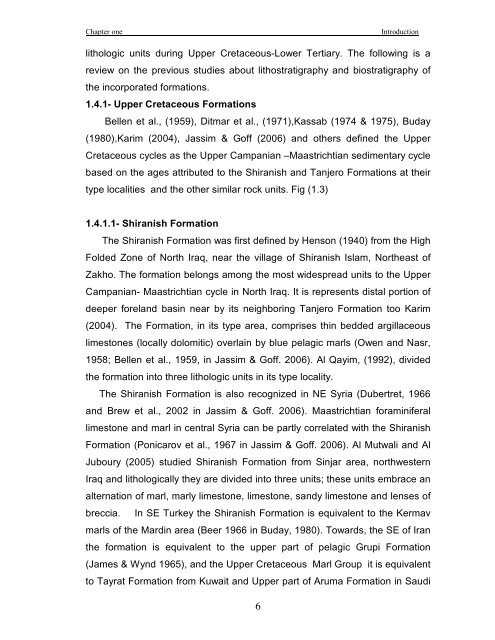biostratigraphy and paleoecology of cretaceous/tertiary boundary in ...
biostratigraphy and paleoecology of cretaceous/tertiary boundary in ...
biostratigraphy and paleoecology of cretaceous/tertiary boundary in ...
Create successful ePaper yourself
Turn your PDF publications into a flip-book with our unique Google optimized e-Paper software.
Chapter one<br />
Introduction<br />
lithologic units dur<strong>in</strong>g Upper Cretaceous-Lower Tertiary. The follow<strong>in</strong>g is a<br />
review on the previous studies about lithostratigraphy <strong>and</strong> <strong>biostratigraphy</strong> <strong>of</strong><br />
the <strong>in</strong>corporated formations.<br />
1.4.1- Upper Cretaceous Formations<br />
Bellen et al., (1959), Ditmar et al., (1971),Kassab (1974 & 1975), Buday<br />
(1980),Karim (2004), Jassim & G<strong>of</strong>f (2006) <strong>and</strong> others def<strong>in</strong>ed the Upper<br />
Cretaceous cycles as the Upper Campanian –Maastrichtian sedimentary cycle<br />
based on the ages attributed to the Shiranish <strong>and</strong> Tanjero Formations at their<br />
type localities <strong>and</strong> the other similar rock units. Fig (1.3)<br />
1.4.1.1- Shiranish Formation<br />
The Shiranish Formation was first def<strong>in</strong>ed by Henson (1940) from the High<br />
Folded Zone <strong>of</strong> North Iraq, near the village <strong>of</strong> Shiranish Islam, Northeast <strong>of</strong><br />
Zakho. The formation belongs among the most widespread units to the Upper<br />
Campanian- Maastrichtian cycle <strong>in</strong> North Iraq. It is represents distal portion <strong>of</strong><br />
deeper forel<strong>and</strong> bas<strong>in</strong> near by its neighbor<strong>in</strong>g Tanjero Formation too Karim<br />
(2004). The Formation, <strong>in</strong> its type area, comprises th<strong>in</strong> bedded argillaceous<br />
limestones (locally dolomitic) overla<strong>in</strong> by blue pelagic marls (Owen <strong>and</strong> Nasr,<br />
1958; Bellen et al., 1959, <strong>in</strong> Jassim & G<strong>of</strong>f. 2006). Al Qayim, (1992), divided<br />
the formation <strong>in</strong>to three lithologic units <strong>in</strong> its type locality.<br />
The Shiranish Formation is also recognized <strong>in</strong> NE Syria (Dubertret, 1966<br />
<strong>and</strong> Brew et al., 2002 <strong>in</strong> Jassim & G<strong>of</strong>f. 2006). Maastrichtian foram<strong>in</strong>iferal<br />
limestone <strong>and</strong> marl <strong>in</strong> central Syria can be partly correlated with the Shiranish<br />
Formation (Ponicarov et al., 1967 <strong>in</strong> Jassim & G<strong>of</strong>f. 2006). Al Mutwali <strong>and</strong> Al<br />
Juboury (2005) studied Shiranish Formation from S<strong>in</strong>jar area, northwestern<br />
Iraq <strong>and</strong> lithologically they are divided <strong>in</strong>to three units; these units embrace an<br />
alternation <strong>of</strong> marl, marly limestone, limestone, s<strong>and</strong>y limestone <strong>and</strong> lenses <strong>of</strong><br />
breccia. In SE Turkey the Shiranish Formation is equivalent to the Kermav<br />
marls <strong>of</strong> the Mard<strong>in</strong> area (Beer 1966 <strong>in</strong> Buday, 1980). Towards, the SE <strong>of</strong> Iran<br />
the formation is equivalent to the upper part <strong>of</strong> pelagic Grupi Formation<br />
(James & Wynd 1965), <strong>and</strong> the Upper Cretaceous Marl Group it is equivalent<br />
to Tayrat Formation from Kuwait <strong>and</strong> Upper part <strong>of</strong> Aruma Formation <strong>in</strong> Saudi<br />
6

















